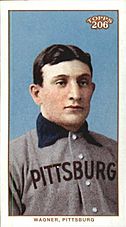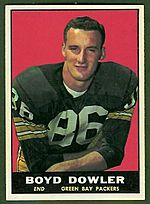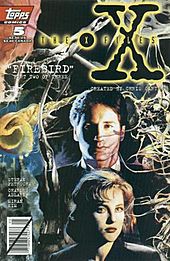Topps facts for kids

Logo used since 1981
|
|
| Private | |
| Industry | Collectibles, confectionery |
| Founded | Brooklyn, New York, U.S. (1938) |
| Headquarters |
95 Morton
,
New York, New York U.S.
|
|
Key people
|
|
| Products | Trading cards, chewing gum, candy |
| Brands | Allen & Ginter Bowman |
| Revenue | $91.6 Million (fiscal 2006) |
| $101 Million (fiscal 2017) | |
| Owner | Fanatics |
|
Number of employees
|
422 |
The Topps Company, Inc. is an American company famous for making trading cards and other cool collectibles. Topps is most known for its baseball cards. They also make cards for other sports and fun non-sports topics.
Topps used to be the only company with a special license to make Major League Baseball cards. But in 2022, another company called Fanatics, Inc. got that license. Later that same year, Fanatics bought Topps.
Contents
The Story of Topps
How Topps Started
Topps was started in 1938 by four brothers: Abram, Ira, Philip, and Joseph Shorin. They first focused on making chewing gum.
One of their first big hits was Bazooka bubble gum. It came with a small comic strip inside the wrapper. In 1950, Topps started putting Western character cards, like Hopalong Cassidy, with their gum. This helped sell more gum.
Soon after, Topps started including baseball cards with their gum. These cards quickly became their most popular product.
The "Father of Modern Baseball Cards"
A man named Sy Berger is often called the "father of the modern baseball card." In 1951, Sy Berger and Woody Gelman designed the 1952 Topps baseball card set. This design included the player's name, photo, team, and a fake autograph on the front. The back had their height, weight, birthday, stats, and a short story. This basic design is still used today.
Sy Berger worked for Topps for 50 years. He was known for signing up baseball players for their cards. He even went to London in 1964 to get the rights for Topps to make Beatles trading cards.
In 1952, Topps had too many baseball cards left over. Sy Berger oversaw dumping many of them into the Atlantic Ocean. These cards included Mickey Mantle's first Topps card, which is now one of the most valuable cards ever. On August 28, 2022, a 1952 Mickey Mantle card sold for $12.6 million!
Topps Becomes a Big Company
Topps started as a partnership and became a company in 1947. Their main office was in Brooklyn. Later, in 1965, they moved their production to Duryea, Pennsylvania.
For many years, Topps was owned by the Shorin family. In 1972, Topps offered its stock to the public for the first time. This meant people could buy shares in the company. In 1984, it became a private company again. Then, in 1987, it went public once more, changing its name to The Topps Company, Inc.
In 2007, Michael Eisner's company, The Tornante Company, bought Topps. Under Eisner, Topps started to create movies and other entertainment based on its products. They planned a Bazooka Joe movie and projects for Garbage Pail Kids and Wacky Packages.
Topps Goes Digital
In 2012, Topps started making digital sports cards for phones and tablets. Their first digital baseball card app, Topps Bunt, came out in 2013. They then made apps for soccer (Kick), football (Huddle), and hockey (Skate).
Topps also made digital non-sports cards. In 2015, they launched the Star Wars Card Trader app. They also created apps for Walking Dead, Marvel, and Disney cards.
In 2020, Topps began putting some cards on the blockchain. This allows people to trade them in a new digital way.
In 2021, Topps planned to become a public company again. The deal valued Topps at $1.3 billion. However, the deal fell through. In August 2021, Fanatics got the exclusive license for Major League Baseball cards. In January 2022, Fanatics bought Topps for $500 million.
Topps Europe
Buying Merlin Publishing
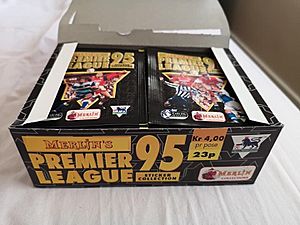
Topps has a European branch located in Milton Keynes, UK. This office helps launch products across Europe and other international markets.
In 1994, a company called Merlin acquired the Premier League license. This allowed them to make the only official Premier League sticker and album collection in the UK. These stickers were very popular.
In 1995, The Topps Company Inc. bought Merlin Publishing. Merlin's official name changed to Topps Europe Limited. However, their products still used the Merlin brand until 2008 because people recognized it.
Topps Europe Limited still makes many sports and entertainment collectibles. These include stickers, albums, cards, magazines, and temporary tattoos.
Topps Europe Products
Topps Europe Ltd. has launched many successful products. Popular licenses include WWE, Pokémon, Doctor Who, High School Musical, and SpongeBob.
Topps Merlin branded Premier League sticker albums have been popular since 1994. In 2007, Topps also got the Premier League rights for trading cards. Their game, Match Attax, became the best-selling boys' collectible in the UK for three years. It is also the biggest-selling sports collectible worldwide. About 1.5 million children in the UK collect it.
In 2008, Topps also got exclusive rights for German football (soccer) cards and stickers. Bundesliga Match Attax launched in 2009 and became very popular in Germany.
In January 2023, Topps released physical and digital trading cards for the 24 Hours of Le Mans Motorsport event. These cards feature artwork from original race posters.
Topps Baseball Cards: A Look Back
Starting in the Baseball Card World
In 1951, Topps made its first baseball cards. They were called Red Backs and Blue Backs. Each set had 52 cards, like a deck of playing cards. You could even use them to play a baseball game.
In 1952, Topps changed its approach. They made a much larger set of 407 baseball cards. These cards came with bubble gum. The cards were bigger and had square corners. They featured a color portrait on the front and stats and info on the back. This set is seen as Topps's first real baseball card set.
In 1957, Topps made its cards slightly smaller. This size (2-1/2 inches by 3-1/2 inches) became the standard for most sports cards in the U.S. Around this time, Topps started using color photographs on their cards.
Cards were released in different series throughout the baseball season. Later series often sold less well. This meant cards from the last series were rarer and more valuable. For example, the 1952 set's last series included card No. 311, which is Mickey Mantle's first Topps card. It is still the most valuable Topps card ever.
The mix of baseball cards and bubble gum was a hit with kids. The cards quickly became the main reason to buy the product. The gum sometimes stained the cards, which collectors didn't like. In 1992, Topps stopped including gum in baseball card packs.
Fighting for Player Contracts
Baseball card companies used to sign individual players to contracts. Topps started doing this in 1950. This led to a big competition with Bowman Gum, another company making baseball cards. Bowman had signed many players to exclusive contracts.
Topps tried to get around Bowman's contracts. In 1951, Topps sold its cards with caramel candy instead of gum. Topps also tried to get players to agree not to sign with other companies.
Bowman sued Topps, saying Topps was copying their ideas. The court case was complicated. During this time, some Topps sets had "missing" cards. These were numbers for players whose cards couldn't be sold legally. The competition ended in 1956 when Topps bought Bowman. This made Topps the main baseball card maker for many years.
Topps's Dominance and New Rivals
The next company to challenge Topps was Fleer. Fleer tried to make baseball cards in 1963 but wasn't very successful. Fleer then supported a government complaint against Topps. The complaint said Topps was being unfair by having all the exclusive contracts.
The government decided that other companies could still sell cards with other small products. However, Fleer sold its player contracts to Topps in 1966. This gave Topps a strong hold on the baseball card market.
That same year, the Major League Baseball Players Association (MLBPA) wanted to get more money for players. They felt Topps wasn't paying players enough for their card rights. After discussions, Topps agreed to pay players more money and a percentage of overall sales.
Because of this history, Topps still uses individual player contracts for its baseball cards. Other companies get group licenses from the MLBPA. This means sometimes a player might have a Topps card but not a card from other companies, or vice versa.
The End of the Monopoly
In the 1970s, Kellogg's started putting "3-D" baseball cards in cereal boxes. Topps didn't try to stop them.
Topps's strong hold on baseball cards finally ended in 1980. A judge ruled that Topps Chewing Gum no longer had the exclusive right to sell baseball cards. This allowed Fleer and another company, Donruss, to enter the market in 1981. They started making large sets of cards to compete with Topps.
Even though the ruling was later changed, Fleer and Donruss found ways to keep selling cards. Fleer included logo stickers, and Donruss included cardboard puzzle pieces. Topps then started releasing "Traded" sets. These sets featured players who had changed teams.
Topps in Today's Baseball Card World
"Traded" or "Update" sets became important for another reason. They included many rookie players who had just reached the major leagues. Companies started competing to be the first to make a card of future stars. They even included minor league players who hadn't played in the major leagues yet. For example, Topps made the first card of Mark McGwire before he became a major league star.
In 1989, Topps brought back its old competitor, Bowman, as a separate brand. Bowman sets focused on young players with bright futures. Also in 1989, Upper Deck entered the market with higher-quality cards. Card companies started making different sets for different types of collectors.
This led to too many different baseball card sets. The MLBPA decided that for 2006, only Topps and Upper Deck would get licenses. They also limited the number of products.
Topps also tried selling cards online. In 2000, they launched eTopps, where cards were sold and traded online. They also bought ThePit.com, a site for online card trading, but it wasn't very successful.
In 2002, Topps brought back the classic T206 Honus Wagner card design from 1909. They made new versions with current players.
In 2009, Topps became the official baseball card of MLB. This gave Topps exclusive rights to use MLB team logos on cards. This deal was extended several times.
In 2020, Topps released a new T206 collection with players from both Major and Minor League Baseball.
At the start of the 2023 MLB season, MLB, Fanatics, and Topps announced a new program. Rookie players wear "MLB Debut" patches on their jerseys during their first game. These patches are then put into special one-of-a-kind Rookie Debut Patch Autograph Cards. These cards are randomly inserted into Topps baseball card packs.
Card Design
Topps played a big role in shaping what people expect a baseball card to look like. They set the standard size and created many design elements.
Using Statistics
One key feature that made Topps popular was including player statistics. In the past, it was hard to find full stats for all players. Topps gathered this information themselves. Collectors loved studying the numbers to compare players or play imaginary games. This also helped kids learn about mathematics.
Early cards showed stats from the most recent year and the player's total career stats. In 1957, Topps started putting full year-by-year stats on the back of the card. This became a permanent feature from 1963 onwards.
Artwork and Photography
Early Topps cards used artist's portraits of players. In 1971, Topps included color photographs from actual games for the first time. The 1971 set is also known for its black borders, which made it hard to find cards in perfect condition.
In 1954, Topps put two pictures on the front of the card: a close-up of the player's head and a full-length pose. From 1957 on, most cards used posed photographs. These photos became sharper and more natural in color by 1962.
Topps also used artwork to show action on some cards. From 1960, a few cards showed real game action, often from the World Series. In 1972, Topps started mixing game photography with posed shots in its sets.
Baseball artist Dick Perez began painting art cards for Topps in 2006. His series include Turkey Red and Allen & Ginter.
Sometimes, early action photos were blurry or included too many players. This made it hard to see the main player. These issues improved over time.
Before stats became the main focus, card backs also featured cartoons. These appeared until 1982. In 1993, Topps finally managed to put a player photo on the back of the card again.
Keeping Cards Up-to-Date
Topps used different ways to keep its cards current. If a player changed teams, Topps tried to show them with their new team. Sometimes, they would airbrush out old team logos from uniforms. Rookie cards were also prepared by airbrushing minor-league uniforms.
In one case, Topps even got ahead of itself. In 1974, they showed players with a "Washington Nat'l Lea." team. This was because the San Diego Padres were expected to move to Washington, D.C. When the move didn't happen, Topps had to replace these cards.
Topps has also made special cards for players who died or were injured. For example, the 1959 set had a "Symbol Of Courage" card for Roy Campanella after he was paralyzed.
American Football Cards
Topps also made cards for American football. They first produced football cards in 1951. After buying Bowman, Topps became the main football card maker in 1956.
Topps sold football cards every season until 2016. When the American Football League (AFL) started in 1960, other companies like Fleer began making cards for that league.
After the AFL and National Football League merged, Topps became the only major football card maker from 1968. Topps also made cards for the short-lived United States Football League in the 1980s. Many NFL legends, like Steve Young and Jim Kelly, had their first cards in these USFL sets.
From the 1970s until 1982, Topps couldn't use actual team logos on helmets and uniforms. These logos were often airbrushed out.
After the 2015 football season, Panini got an exclusive license from the NFL. This meant Topps stopped producing football cards in 2016.
Trading Cards for Other Sports
Topps also makes cards for other major North American sports. They started with ice hockey cards in 1954.
In 1958, a Canadian company called O-Pee-Chee partnered with Topps to make NHL and Canadian football cards. They later started printing their own cards.
Topps first sold cards for basketball in 1957 but stopped after one season. They started again in 1969 and continued until 1982. Topps returned to basketball cards in 1992, just in time for Shaquille O'Neal's rookie year.
In the UK, Topps acquired a firm in 1974 to make football stickers. Topps also makes cards for the Scottish Professional Football League. Under its Merlin brand, it has the license for Premier League stickers and the national team. Their main competitor is Panini. Topps also produces stickers and trading cards for the UEFA Champions League.
In 2008, Topps gained the rights to make WWE trading cards. The first set was called Slam Attax. Topps also signed a deal in 2008 to produce mixed martial arts trading cards for the UFC.
Non-Sports Products
Topps started as a gum company. Its first product was "Topps gum." They later made other gum and candy products. Topps also began making funny products not related to sports. These included stickers, posters, and toys. More recently, they published comic books and games.
Candy and Gum
The longest-running Topps product is Bazooka bubble gum. It was introduced in 1947. In 1953, Topps started selling smaller pieces with the Bazooka Joe comic strip.
Topps also developed other candy items, often involving gum. However, sales dropped in the 1970s when softer bubble gums like Bubble Yum came out.
Later, Topps added more candies without gum, like Ring Pops and Push Pops. Topps has noted that people caring more about healthy eating affects their candy sales.
Other candy brands include Baby Bottle Pop and Juicy Drop Pop.
When Fanatics bought Topps's trading card business, the candy business was separated. It is now called Bazooka Brands and is owned by the previous owners.
Non-Sports Trading Cards
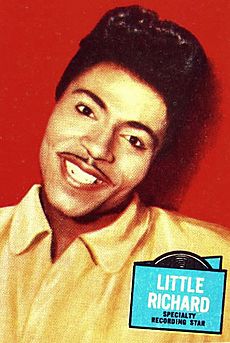
As sports cards used more photos, Topps focused its art on non-sports trading cards. These cards were inspired by popular culture. For example, the Space Race led to Space Cards in 1958. Topps continues to make collectible cards and stickers on many topics. These often cover movies, TV shows, and other cultural events, like the Beatles or Star Wars.
Many Topps artists also worked in comics. They were good at mixing humor and horror, like with the Funny Monsters cards in 1959. The 1962 Mars Attacks cards later inspired a Tim Burton movie.
Some of Topps's most famous funny and parody cards include Wacky Packages, which made fun of household products, and Garbage Pail Kids, which parodied Cabbage Patch Kids dolls. Another popular series was Civil War News.
In the 1960s, Topps had many successful parody card series. These often featured artists from Mad magazine. They made funny insult-valentine cards, product advertising parodies, and bizarre alien cards.
While baseball cards have been very profitable, non-sports items sometimes become very popular. For a time in 1973, Wacky Packages stickers sold more than Topps baseball cards. Pokémon cards did the same for a few years starting in 1999.
In 2015, Topps expanded its non-sports category. They added more TV shows and sci-fi lines like Star Wars and Doctor Who.
Disney Channel
Topps worked with the Disney Channel to create trading cards for High School Musical, High School Musical 2, High School Musical 3, and Hannah Montana.
Comic Books
In 1993, Topps started a division to publish comic books called Topps Comics. They often published comics tied to movies or TV shows. Their longest-running and best-selling comic was The X-Files, based on the TV show.
Some other famous titles included Lone Ranger and Tonto, Xena: Warrior Princess, and Zorro. Topps stopped publishing comics in 1998.
Games
Topps entered the world of games in 2003 by buying the game company WizKids. This gave them rights to game universes like BattleTech and Shadowrun. WizKids also created a new type of game called Pirates of the Spanish Main. Topps closed WizKids in 2008 due to economic problems. Another company, NECA, bought the brand in 2009.
Awards
Major League Baseball
- Topps All-Star Rookie Team
Minor League Baseball
- Topps Minor League Player of the Year Award – also known as the J. G. Taylor Spink Award
- George M. Trautman Awards – Topps also gives the George M. Trautman Awards to the Topps Player of the Year in each of sixteen minor leagues.
- Topps Short Season-A/Rookie All-Star Team
Images for kids
See also
- Topps baseball card products
- Allen & Ginter
- Bowman
- Donruss
- Fleer
- Razor Entertainment
- Upper Deck Company
Most valuable Topps cards from the 1950s (https://www.throwbacksportscards.com/most-valuable-baseball-rookie-cards-of-1950s)



